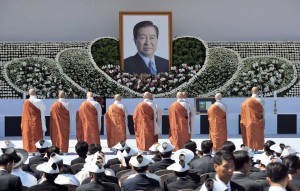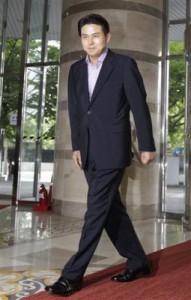Demography is Destiny: Why South Korea Hasn’t Seen the Last of the Sunshine

The autobiography of the late President Kim Dae Jung, best known for his “Sunshine Policy” of engagement with North Korea, recently hit bookshelves in Korea. Kim’s election in 1997 on his fourth try for the presidency marked the first peaceful transition to an opposition party in Korean history and ushered in an unprecedented 10 years of liberal rule. Many of the ruling elite saw Kim and his successor, Roh Moo Hyun (especially Roh), as interlopers, and viewed the election of the current president, Lee Myung Bak as a return to normalcy.
The results of South Korea’s June 2 local elections, therefore, came as something of a shock. Before the sinking of the Cheonan on March 26, the ruling Grand National Party (GNP) seemed in good shape to make further gains. South Korea had beaten most of the industrialized world in recovering from the global financial crisis, and President Lee enjoyed relatively high approval ratings. A security crisis like the Cheonan incident would normally be expected to further rally support for the conservative party. Indeed, the GNP tried to use the incident to its advantage, with then-party chairman Chung Mong Joon going as far as saying that the main opposition Democratic Party, because of its support for North Korea, “should be taking as much of the responsibility as North Korea’s leader Kim Jong Il” for the sinking.
While local issues—such as opposition to the Four Rivers Project and the ever-shifting plans for Sejong City—undoubtedly played an important role in the ruling party’s disappointing results, the most telling aspect of the election was the party’s poor showing among younger voters. These were the same voters who joined with the conservative party’s traditional base—older voters and those from the southeast—to put Lee Myung Bak into power. The results demonstrated that people in their 20s and early 30s have emerged as South Korea’s swing voters, a distinction they are likely to maintain in future elections.
The demographic voting patterns in South Korea are closely tied to the country’s turbulent history. The older generations—now ages 50 and above—experienced division, war, and poverty. Many still harbor personal memories of the horrors of the North Korean invasion. Most credit the United States for having saved them from communism and having helped lift them to the level of one of the world’s leading industrialized nations. They remain strongly anti-communist and pro-American, favor growth-oriented economic policies, and generally vote for the conservative party in elections.
The middle generation was once known as the “386” generation—i.e. people in their 30s, who went to college in the 1980s, and were born in the 1960s. As we enter the second decade of the twentieth century, they’ve been “upgraded” to “486s.” This generation is too young to remember the Korean War, and grew up during a period when high economic growth was a given. They experienced the violent upheavals of the 1980s, starting with the assassination of Park Chung Hee, followed by Chun Doo Hwan’s military coup and the Gwangju massacre. They spent their college years on the front lines of the fight for democracy while the United States openly supported Chun’s military government. They tend to be sympathetic toward North Korea and suspicious of the United States. Economically, they seek greater equality and increased spending on social welfare. They were the main supporters of former presidents Kim Dae Jung and, especially, Roh Moo Hyun.
Today’s young people—18-35 year olds born between 1975 and 1992—were born into an advanced economy and democratic society. They have never known war or poverty, and most are too young to remember life under a dictatorship. They have experienced three economic crises; the most jarring of these was the so-called “IMF crisis” of 1997, because it led to the end of the old “lifetime employment” system. No longer could college students look forward to getting a job at a chaebol right after graduation and expect to pass through a series of pre-determined promotions until reaching retirement age. Unemployment, layoffs, and irregular work became more widespread. The young South Koreans of today are cosmopolitan, pragmatic, job-oriented, and hyper-competitive.
Young voters lined up in support of Lee Myung Bak in 2007 because they hoped the former business executive would be able to restore the days of high growth and thus create jobs. One of Lee’s campaign slogans was “747”—7 percent growth, US$ 40,000 per capita GDP, and South Korea becoming the seventh largest economy. While those hopes have failed to materialize, partially due to the global economic crisis and partially because they weren’t entirely realistic to begin with, Lee’s overall record on the economy has been pretty good. South Korea was the first OECD country to recover from the global recession and it currently projects an annual growth rate of nearly 6 percent.

The success, however, has not been felt across the board. Companies coming out of the recession but faced with continued global uncertainty have focused on rehiring older workers rather than training younger workers for future expansion. As a result, youth unemployment remains high. Twenty-something job seekers complain that employers cling to the older way of hiring, favoring graduates of the so-called “SKY” universities (Seoul National, Korea, and Yonsei) over candidates from lesser-known schools who might have more accomplishments under their belts. Recent college graduates forced to take short-term contracts long for the job stability that their parents enjoyed. Thus retaining the loyalty of younger voters will take more than just a higher GDP; policymakers must somehow address the structural changes that are contributing to career anxiety in the young generation. In recognition of this problem, Lee Myung Bak nominated a 47-year old former provincial governor, Kim Tae Ho, as the new prime minister with the explicit mission of reaching out to younger voters.
While younger voters remain focused on jobs, they are far less interested than their elders in the settling of past scores. Just as Republican attempts during the 2008 U.S. presidential election to revive the battles of the 1960s by tying Barack Obama to former Weatherman radical, William Ayers, failed to persuade young American voters, today’s attempts by both liberals and conservatives in Korea to revive the battles of the 1980s has little resonance among people who were in their infancy during that time. This includes the Truth and Reconciliation Commission, set up under Roh Moo Hyun to look into past human rights abuses, but criticized by conservatives as an attempt to discredit political enemies.
Since regaining power, conservatives have attempted to reverse these trends, rewriting textbooks to remove what they termed “leftist distortions” and cracking down on teachers and other public employees who engaged in political activities. But the intolerance of dissent and quickness to resort to legal measures against their political opponents has reminded many Koreans of the civil rights abuses of past military dictatorships. This is why the GNP’s attempt to “securitize” local elections after the Cheonan incident, rather than having the rally-round-the-flag attempt they were hoping for, only reinforced the sense that the Lee administration was using the threat of North Korea for their own political purposes. Foreign Minister Yu Myung Hwan’s rant at the ASEAN Regional Forum that young people who voted for the opposition party should “go live under Kim Jong Il” certainly did nothing to expel those notions.
The public reaction to the Cheonan incident also demonstrated that a substantial portion of the South Korean electorate still supports a policy of engagement toward North Korea. While inconsistencies and lack of transparency around the Cheonan investigation may have contributed to the skepticism that has surrounded the government’s report, for the most part, the reaction has followed predictable lines. Supporters of the sunshine policy reject it as a frame-up, while proponents of taking a hardline embrace it as further proof of Pyongyang’s perfidy. Neither Lee Myung Bak’s hardline policies nor North Korea’s actions have convinced “sunshiners,” particularly among the 486 generation, that they should give up the pursuit of engagement and reconciliation.
If conservatives wish to remain in power beyond the end of Lee Myung Bak’s constitutionally-limited single term, they will have to address the concerns of younger voters, and not simply rely on the twin pillars of economic growth and anti-communism that have long been the mainstays of the Korean right. But even should they succeed in winning back young voters, it may not be enough to fight off a liberal comeback. Older generations inevitably die out, and the ranks of the young generation are not being replenished quickly enough. Korea has one of the lowest birth rates in the world—1.22 births per women by current estimates. This means that the 486ers, Korea’s baby boom generation, will occupy an even greater share of the country’s population than they already do. Unless this group changes its established voting patterns, an eventual return to liberal rule is highly likely, perhaps as soon as the next presidential election.
This possibility has profound implications for U.S.-South Korean attempts to coordinate their policy approach toward North Korea. In the past, South Korea and the United States were often at odds: South Korean President Kim Young Sam opposed U.S. President Bill Clinton’s engagement policy, and George W. Bush answered Kim Dae Jung’s sunshine policy with his “axis of evil” speech. This proved disastrous from a policy standpoint; neither confrontation nor engagement proved effective when only one ally was fully committed.
The Obama administration has attempted to avoid this trap by allowing Seoul to take the lead on North Korea while Washington provides full support. This has succeeded in sending a unified message to the North, but has not done anything noticeable to change Pyongyang’s behavior. Officials on both sides agree that U.S.-South Korean relations are at their best state in years, despite some lingering differences over their pending free trade agreement.
But will this closeness survive a change in government? If the 2012 election in South Korea brings a return of a liberal proponent of the sunshine policy, will Obama or his successor likewise change tact in the name of continuing harmonization of North Korean policy? Or will Seoul and Washington once again find themselves, as the old Chinese saying goes, sharing the same bed but dreaming different dreams?
